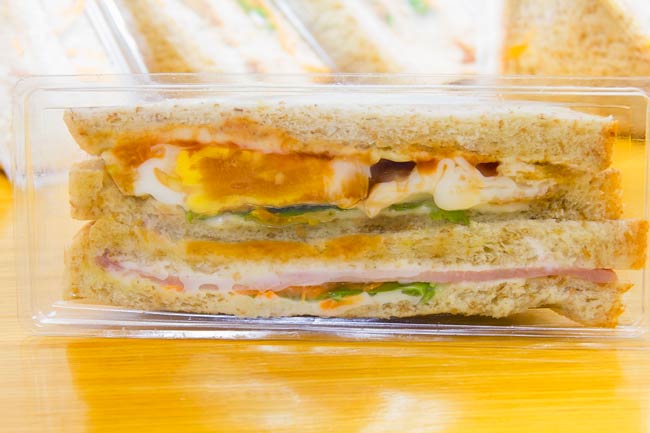- Make It Yourself Lavender Heart-Shaped Bath Bombs!
- 20 Things You Never Knew About “Down There”
- 12 Best Foods For Those Suffering From Arthritis Pain
- 12 Personal Hygiene Mistakes Almost Everyone Makes (Mom Never Told You About #4!)
- 15 Medicinal Plants And Herbs From The Cherokee People
- 12 Mind-Blowing Benefits Of Drinking Coconut Water During Pregnancy
- 12 Outstanding Winter Foods That Won’t Fatten You Up Like A Christmas Turkey
Top 20 Dangerous Foods You Absolutely Must Avoid
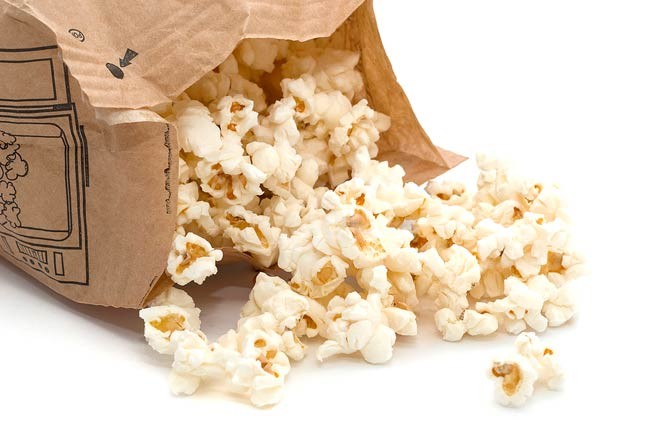
Photo credit: bigstock
Everyone knows the foods that are healthy and those that are not, right? Yet, there are still a lot of those foods on the store shelves that are being advertised as the “healthy option”, but really are far for being a decent choice. In fact, some of the worst offenders are filled with ingredients that, on top of being unhealthy, keep those inches on your waistline and won’t let you take off those extra pounds. There are still other foods that, although they actually are healthy, they are simply too dangerous to consider eating. There are dozens of foods which would make this list and it might be hard to avoid them, but let’s take a look at just the top 20 dangerous foods that you should never eat and remove from your diet if you care at all about your health.
20. Microwave Popcorn
Those little bags of popcorn are just so convenient and easy to use. They seem so harmless, don’t they? They are anything but.
First, let’s start with the bag itself, which is lined with a chemical called PFOA, or perfluorooctanoic acid. Maybe you have heard the warning that your non-stick pots and pans are toxic? Your microwave popcorn is lined with the same toxic non-stick lining. When heated this chemical has been shown to cause cancer and infertility in lab animals.
The popcorn itself doesn’t appear to be GMO, but you can’t be sure since there are no labeling requirements. However, there are other ingredients that definitely are such as the oil and the emulsifiers, not to mention that these oils contain huge amounts of trans-fats.
Last is that “butter flavor.” This is made from a chemical called diacetyl, which is so toxic that one brand of popcorn, ACT, actually removed it because it was making their own factory workers seriously ill. This chemical is also listed as a known carcinogen as well.
There is no need to buy microwave popcorn when it is SO easy to make your own at home.
Continue to Page 2
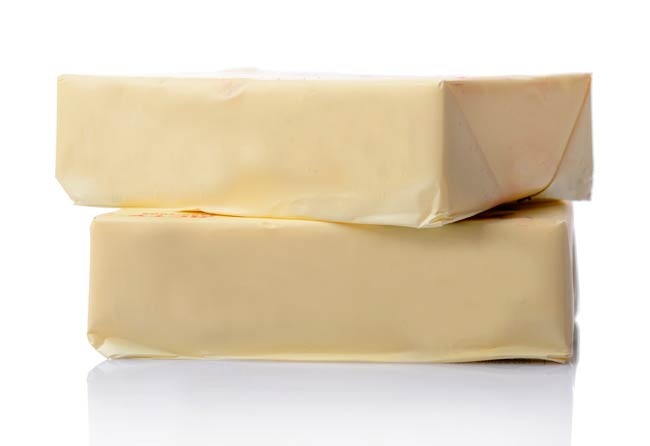
Photo credit: bigstock
19. Stick Margarine
Although long touted as the healthier alternative to butter, this is another falsehood. Stick margarine contains excessive amounts of trans-fats, the ones that cause damage your blood vessels and arteries, not to mention the calories. Most stick margarine has at least 100 calories in one tablespoon!
At one time it was thought that, by avoiding animal fats, margarine was a healthier choice, however, over the years researchers have discovered that natural butter, from organic, grass fed cows of course, is better for your body in the long run rather than subject your body to all the trans-fat, salt, and artificial colors and flavors that margarine has.
Besides tasting great, (nothing like the real thing) butter is a great source of those healthy saturated fats, fat soluble vitamins, and other vitamins. If you are concerned about the calories or salt content, they do sell unsalted butter.
You can also try using whipped butter that is sold in tub containers. Whipped butter has more air, therefore less fat and fewer calories.

Photo credit: bigstock
18. Pancakes from Pancake Mix
Pancakes are such a nice breakfast choice on a Sunday morning.
Americans love their pancakes so much there is even a National Pancake Day! However, you might be surprised by what’s in your boxed pancake mix.
Pancake mix from a box seems harmless enough, so much so that you might not even realize that it contains trans-fats because it’s a powder. However, Bisquick has almost 5 grams of trans-fat in each cup of mix! Also, if you read the label, most pancake mixes contain partially hydrogenated soybean or cottonseed oil. Make that GMO soybean or cottonseed oil.
If you continue reading you will see that it also contains preservatives and salt. Ditch all those artery clogging trans-fats and GMOs and mix up your own pancakes from scratch.
Cooking from scratch is cheaper and you will know exactly what is in those pancakes you are making for your family. It’s just as easy as the boxed mix and much healthier.
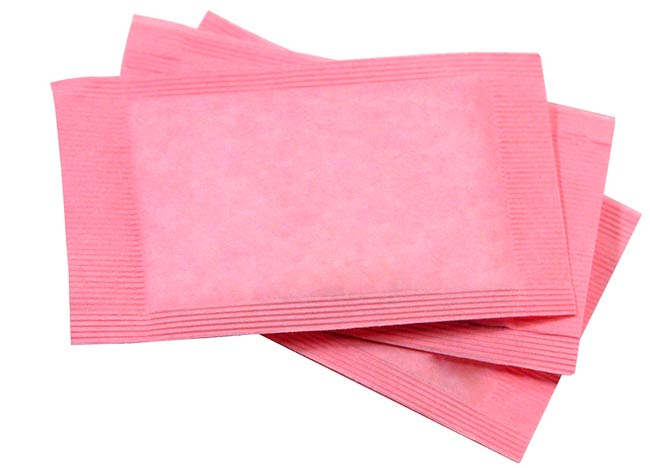
Photo credit: bigstock
17. Anything with artificial sweeteners
Although the media has told you that artificial sweeteners are the wave of the future, the “have your cake and eat it too” sort of thing, they have lied to you. Artificial sweeteners inhibit your body’s natural ability to know when it has consumed too many calories so you will, more than likely, overeat.
These chemical sweeteners also seem to make your body crave even more sweets! You’ve probably heard that drinking those diet sodas actually make you fatter? Well, it’s actually worse than that. Studies show that drinking diet soda more than doubles your risk for obesity!
There is tons of data that also shows that, for those with diabetes, aspartame actually worsens their insulin sensitivity even more so than sugar does. Not to mention that studies show those who consume large amounts of artificial sweeteners usually have some type of kidney malfunction.
Be smart, avoid this chemical!
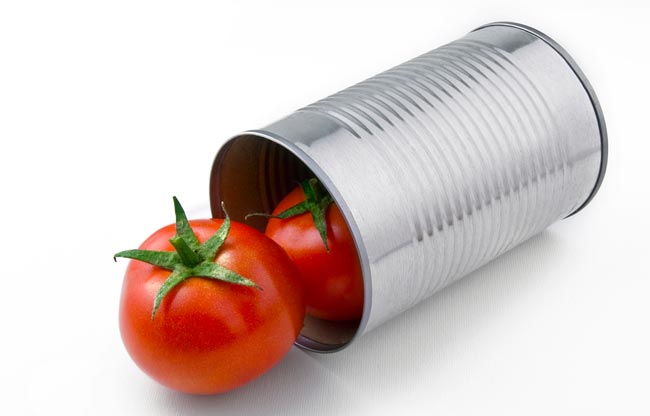
Image credit: bigstock
16. Tomato Sauce
Tomatoes themselves are very good for you, loaded with vitamin C, iron, and vitamin A. Although it might seem easy to pick up a can or bottle of tomato sauce for your pasta dinner, what’s actually in that container might surprise you.
What else besides tomatoes does tomato sauce have, you might be asking? Great question. Need a highly qualified PhD/MBA/Master’s dissertation writer?
Commercially produced tomato sauce is loaded with refined sugars. Read the label. Some brand of tomato sauce list corn syrup as the second ingredient! More than likely, you already have too much sugar in your diet; surely you don’t need it in your tomato sauce. Many tomato sauces also contain sodium.
Besides the health issues, a bottle of tomato sauce typically runs about 2-4 dollars for 12 ounces. Fresh tomatoes can often be found for a dollar a pound. It’s so easy to make your own, fresh tomato sauce at home!
It’s a healthier, as well as much more inexpensive option to make your own.

Photo credit: bigstock
15. Frosting
Ok, so perhaps this is a no brainer. Frosting isn’t healthy, everyone knows, but it doesn’t stop you from enjoying some now and then does it?
Perhaps you would think differently if you really knew the ingredients in that little package of frosting. Canned or packaged frosting is just a mixture of trans-fats and corn syrup, with preservatives, artificial colors, and artificial flavors. Not quite the treat you pictured, is it?
Many contain food colorings that are banned in most other countries. Read the labels. Many of them state they contain soybean or cottonseed oil. What they don’t tell you is that those are GMO soybeans or cottonseed oil.
Some of them also contain two different types of sugar.
One label (Betty Crocker) simply says “sugar” as the main ingredient, which means it’s more than likely from GMO sugar beets, and then high maltose corn syrup, aka, high fructose corn syrup. It’s interesting to note that even the frosting that states its flavor is vanilla, so it should be white in color, has artificial colors.
Do you really want (or need) all these things in your body? Stay away from this one.
14. Packaged Sandwiches
When you are in a rush for lunch you might think that picking up a premade sandwich is a healthier choice than fast food, but you would be making a mistake about that.
Although convenient, prepackaged sandwiches are neither worth the money nor the health problems. An average sandwich has more than 400 calories in the sandwich alone. This is crazy when you consider, for some people, your entire lunch should have that amount of calories!
Many of them can make you exceed your daily fat and salt intake in just that one meal. Most are made with white bread, which is essentially empty calories. Although you probably already know that mayonnaise isn’t healthy, you might not know that just one tablespoon has 11 grams of fat.
Most prepackaged sandwiches come with at least 4 tablespoons of mayo.
If your sandwich comes with cheese (usually American cheese or sometimes a cheese “product”), just one ounce contains more than 10 grams of fat.
Most sandwiches use the unhealthiest type of meat you can possibly use, such as bologna or salami. Most of these types of lunchmeats use the “leftover” parts of the animals such as the heart, intestines, and stomach.
Kinda gross, isn’t it? Think of your health and make your own sandwiches at home.

Photo credit: bigstock
13. Non-organic Strawberries
Strawberries look so clean and pure but have you ever seen workers in strawberry fields? They must wear protective suits when working to keep from being exposed to the dozens of pesticides that are sprayed on strawberries regularly.
A new report that was done by the US Department of Agriculture discovered that strawberries contained more than 13 different pesticides. Doesn’t that sound yummy?
You may have heard that the EPA forbid the use of one pesticide, methyl iodide, because it was shown to be a known carcinogen, however, that doesn’t mean there aren’t a multitude of other pesticides being used.
Although California is leading the way to investigating the use of non-toxic, or at least less toxic, means of controlling insects and fungi, you should note that these are small scale studies.
Virtually all of these juicy fruits are still being sprayed with tons of extremely toxic chemicals. These pesticides are absorbed into the strawberries, so washing them doesn’t work. Be safe.
Buy only organic strawberries.
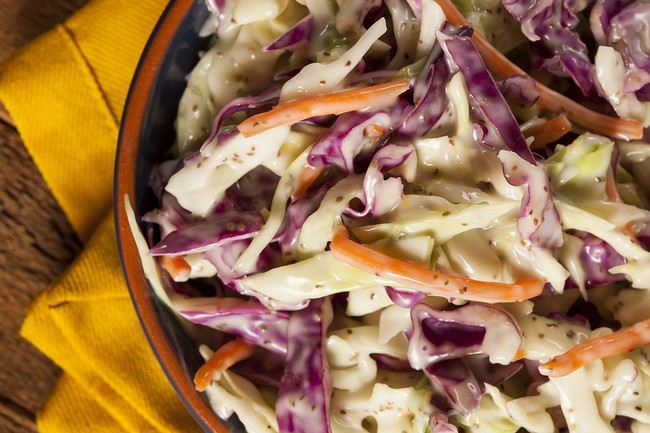
Photo credit: bigstock
12. Coleslaw
Here is another marketing genius, making people believe that this is somehow a healthier option.
True, it contains cabbage and carrots, both of which are very good for you, but it is simply loaded with calories, sugars, and a tremendous amount of fat.
The fat comes from the mayonnaise and some chain brands, such as KFC, have even more fat in a serving of their coleslaw (22 grams) than a large serving of French fries! (19 grams.) Now, you would never think of French fries as healthy, but if no one told you otherwise, you would never believe that a “salad,” such as coleslaw, would be worse for you than your fries.
Take a look at the nutritional info all fast food joints post, don’t assume anything! Your best option here, if you love coleslaw, is to make it yourself at home with low fat mayo or yogurt instead.

Photo credit: bigstock
11. Sprouts
This is one of those items you look at and say, “What? How can sprouts possibly be unhealthy?”
The issue with sprouts is that they have been part of so many recalls due to health issues, it’s hard to keep track of them all. Seriously, just in the past 20 years, there have been more than 40 recalls due to contamination and it doesn’t matter which kind of sprout we are talking about, bean, alfalfa, or peas.
The very thing that makes sprouts grow, warm moist conditions, are also the ideal conditions for making bacteria like salmonella, E.coli, and listeria grow. Also, when you buy sprouts from a store, you have no idea how old they really are and sprouts can grow dangerous bacteria in a matter of days if not handled properly.
Don’t take the risk; eat cabbage or carrots instead, or, grow your own sprouts at home so you know what is in them and who has handled them.
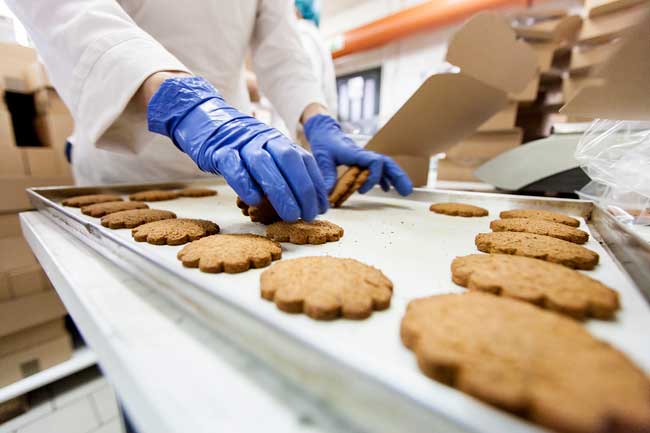
Photo credit: bigstock
10. Packaged Cookies

Photo credit: bigstock
9. Frozen Pizza
You know pizza isn’t the best food choice, but were you aware that just one slice of commercial pizza contains one full days’ worth of salt?
This depends on the toppings and crust, of course, but almost everything about a pizza contains salt and MSG including the dough and the cheese, and if your pizza contains processed meats such as sausage or pepperoni, then you get a huge dose of nitrates along with your salt intake.
Pizza is also unbelievably high in fats. Most of that comes from the cheese, that’s true, but many pizza sauces also contain palm oil or corn oil as well as sugar.
Did you know that just once slice of a deep dish pizza has, again depending on your toppings, approximately 400 to 500 calories? An as much as 30 grams of fat per slice.
Many people eat at least 3 slices of pizza, not including those bread sticks many places include with delivery.
Make your own vegetarian pizza at home for a healthier option.
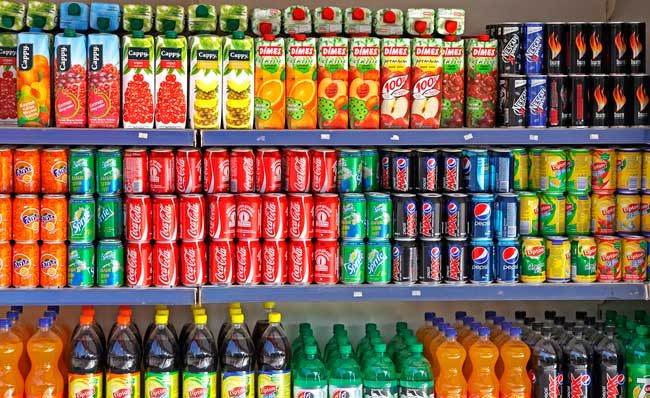
Photo credit: bigstock
8. Sodas
It doesn’t matter if its diet or regular, all sodas are dangerously unhealthy. Even knowing this, Americans still drink almost 56 gallons of soda every year on average!
They may try to claim that they use natural ingredients, which is partially true, if you want to consider as much as 26 teaspoons of sugar in a 12 ounce drink “natural.”
The over consumption of sugar can lead to an insulin reaction in your body that can, in the long run, lead to diabetes as well as weight gain. Most soda makes use high fructose corn syrup as their sweetener, which means it’s GMO corn.
Another main ingredient in sodas is phosphoric acid, which keeps your body from absorbing calcium. Without calcium your body cannot build bone and this can lead to osteoporosis, especially in women.
There is no guarantee that the water used in sodas is anything more than local tap water, which means it can contain fluoride, chlorine, and other contaminants.
They do use artificial colors and flavors as well as those “natural” ingredients. There is absolutely no nutritional value to soda whatsoever, who why drink it?
Save your health and save a fortune, also, and drink Mother Nature’s truly all natural drink: water.
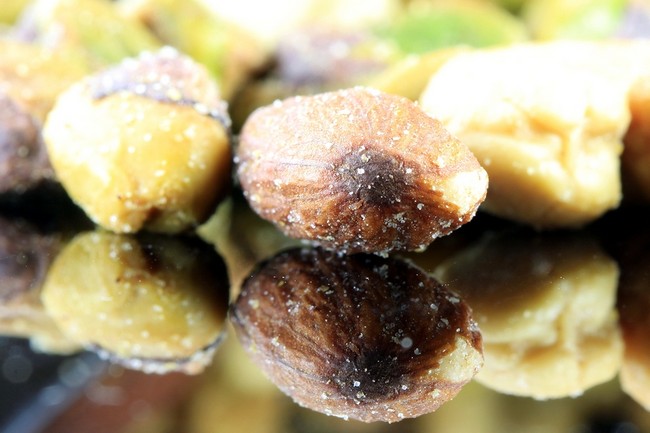
Photo credit: bigstock
7. Salty Snacks
Do you remember that famous potato chip commercial that touted “Betcha can’t eat just one”?
That’s the problem with salty snacks. The more you eat, the more you want, so the more you will eat. Talk about a lot of extra empty calories!
Besides the high salt content, almost all salty snacks are fried with partially hydrogenated oils (again, read GMO oil) which make them loaded with trans-fats.
A new study shows that after eating a salty treat such as potato chips or salted nuts, the damage to your arteries can be seen in just 30 minutes! Extremely salty foods reduce the ability of your blood vessels to widen, so says a study published in the American Journal of Clinical Nutrition.
Read the labels and you will also find that these foods usually use artificial flavors, seasonings, and colors to make them more appealing. The damage that is being done to your heart and arteries is definitely NOT so appealing, however.
Be smart! Save money and learn to cook at home. It’s safer, it’s cheaper, and it’s much, much healthier!

Photo credit: bigstock
6. Ketchup
Ok, so most ketchup ends up on French fries and hamburgers, right?
What you didn’t know, however, is that simple ketchup it making your already unhealthy fries and burger even worse.
The second biggest ingredient in ketchup is high fructose corn syrup (sugar). That means that it’s GMO corn. Some labels even state that their ketchup has two different kinds of sugar!
Combining sugar and fats (ketchup on your fries) is a dangerous combination as far as your health is concerned. Also, the ketchup is usually listed as being from concentrate, which means it’s been heated and boiled down. This removes many of the nutrients that would give it any health benefits.
Many brands of ketchup also contain excessive sodium levels, artificial colors, and artificial flavors, as well as a ton of preservatives. Most of these things are just not good for your body.
If you love ketchup, look for ketchup that has little or no added sugars and keep your consumption to a minimum.
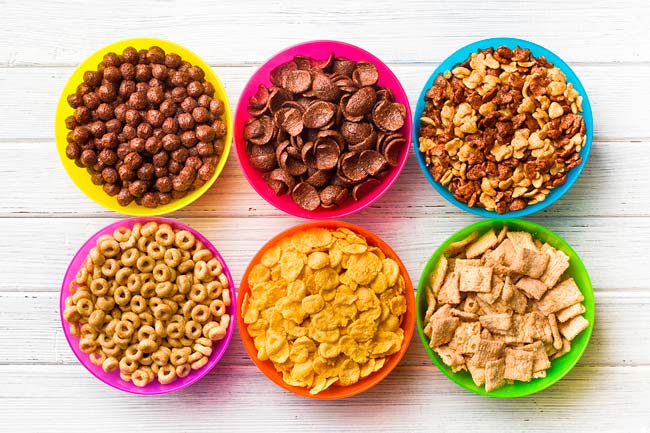
Photo credit: bigstock
5. Packaged Cereals
Here is another marketing ploy that has worked well. Many people believe packaged cereals are a healthy choice for breakfast.
Perhaps they use to be at one time, but now cereals are laden with everything you absolutely are trying to avoid. Sugar being the first one. Some cereals list sugar as their second ingredient!
Right behind that GMO corn they are using.
Think that you are eating “healthy” cereals? Think again. Kashi, one of the best known “healthy” cereals, contains GMO products.
Quaker Oats uses sulfuryl fluoride to store their oats. This chemical is a toxic gas and hardly “natural.”
Also, all those little shapes like puffs or stars or O’s are made by a machine called an extruder. This mixes the grains with water and then at a high temperature, shoots it out little holes into those shapes. Almost all nutrients are cooked out of the grains during this process.
You should note too that all cereals contain artificial colors, flavors, and huge amounts of preservatives. Cereals don’t have to be bad, though.

Photo credit: bigstock
4. Ranch Dressing
How Americans love their ranch dressing! We put it on everything, don’t we?
Burgers, fries, salads, pizzas… we even use it to dip our “healthy” vegetables in it! Although ranch dressing does taste great, it’s not so great for your health.
Each tablespoon (and that’s not much) has more than 75 calories. What most people would consider a “normal” serving, at least one ounce, has 137 calories and more than 7 grams of fat!
Most people eat approximately 100 grams on an average salad. 100 grams is almost 500 calories! Sure turns that diet salad into a whole other monster, doesn’t it? Especially when you consider a Big Mac from McDonald’s has about 525 calories.
Ranch dressing is also loaded with sugar, modified food starch, artificial flavors, artificial colors, and malt dextrin, all things you don’t need in your body. Ranch dressing may taste good but it’s not worth damaging your health or ruining your diet for.
Use a homemade option if you simply can’t resist.
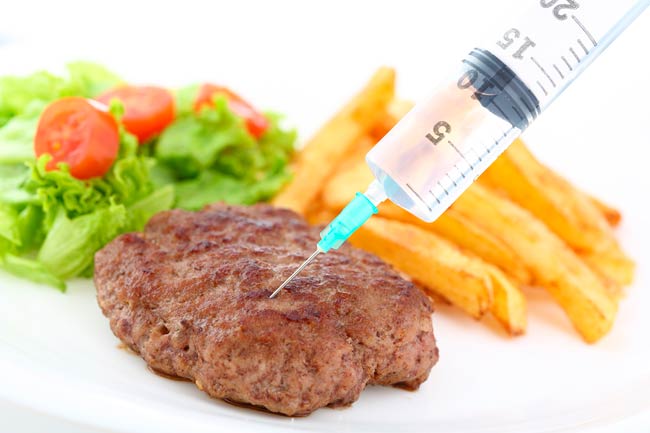
Photo credit: bigstock
3. Mechanically Produced Hamburgers
When you see those large packages of industrially produced hamburgers, think of this: Crowded cattle that are raised in filthy stalls pumped full of antibiotics and hormones, eating diets that are, at best, revolting.
Your single hamburger patty doesn’t come from just one animal, either, but rather, it’s a combination of hundreds of cows. That means there is a bigger risk for E.coli contamination.
This ground beef also contains something you may have heard of recently, called pink slime. Pink slime is the fat that the slaughter house cuts off the meat portion of the cow. It used to be sold only as dog food, but now this pink slime is doused with ammonia, then ground up with the meat itself as filler.
The USDA doesn’t think this pink slime needs to be labeled since, in their logic, it IS part of the cow, therefore, in their minds anyway, it’s beef. Doesn’t that sound good on the family grill?
Be safe and eat healthy. Eat only grass fed beef.
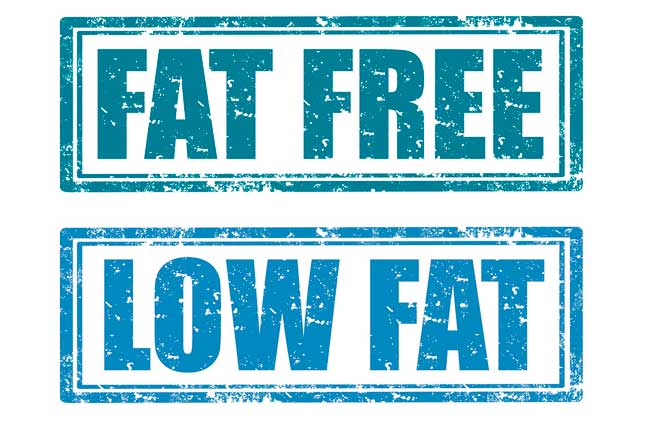
Photo credit: bigstock
2. Packaged Diet Snacks
We’re talking about those popular little 100 calorie “diet” snack packs which are so appealing because you figure you won’t overeat if you eat just one of these little packages.
Honestly now, how many of you actually eat only one package? No matter how cute they are, the bad nutritional content inside doesn’t change with the packaging.
Think about it: a piece of fruit is also only 100 calories. In order make these snacks tasty they frequently contain unnamed artificial sweeteners, or plain old sugar. Oh, excuse me, that would be corn syrup; GMO corn syrup.
Now, we know artificial sweeteners are not good for you, but why won’t the manufacturers name the ingredients in their food? What are they hiding or what is it that they don’t want you to know?
If you don’t know what is in your food, then don’t eat it.
Choose a piece of fresh, organic fruit instead. You will be much more satisfied and your body will appreciate it.
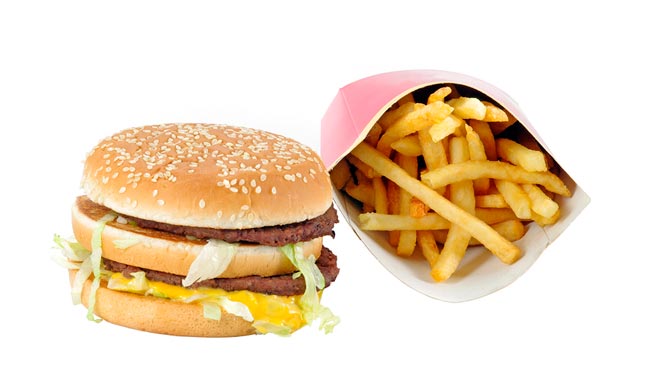
Photo credit: bigstock
1. Anything from fast food chains
Fast food joints certainly are not thinking about food when they are serving you; they are only thinking of their profits and their stockholders. Although everyone knows fast food is not healthy, it seems Americans just can’t leave it alone.
That’s probably because of all the added trans- fats, salt, chemicals like MSG, and sugars that are added to the food to make it taste so good. For example, those “specialty” burgers all the fast food places are pushing: did you know that some of those burgers (such as McDonald’s double quarter pounder with cheese) have more than 19 grams of saturated fats?
Let’s not forget about portion size, either. A large serving of French fries from McDonald’s has 4 days’ worth of Trans fat all by itself.
All fast food is loaded with everything bad you want to avoid: GMO corn, trans- fats, commercialized beef, food dyes, artificial sweeteners, sugar, excessive salt, and many, many others. We haven’t even gotten to the preservative factor!
Eat smart and never eat all fast food like the plague!

